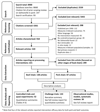A Rapid Systematic Review and Meta-Analysis of the Efficacy of Slaughter and Processing Interventions to Control Non-Typhoidal Salmonella in Beef and Pork
- PMID: 28104927
- PMCID: PMC5238939
- DOI: 10.4315/0362-028X.JFP-16-203
A Rapid Systematic Review and Meta-Analysis of the Efficacy of Slaughter and Processing Interventions to Control Non-Typhoidal Salmonella in Beef and Pork
Abstract
Pork is one of the major food sources of human salmonellosis worldwide, while beef products have been implicated in numerous foodborne outbreaks. As a result, effective interventions to reduce Salmonella contamination during beef and pork processing are of interest to both regulators and industry. We conducted a rapid systematic review and meta-analysis of literature investigating the efficacy of slaughter and processing interventions to control Salmonella in beef and pork. Review steps included: a comprehensive search strategy; relevance screening of abstracts; relevance confirmation of articles; data extraction; risk-of-bias assessment; meta-analysis (where appropriate); and a weight-of-evidence assessment. A total of 191 relevant experimental studies were identified. Two controlled trials indicated that hot water and steam treatments are effective at reducing the prevalence of Salmonella on beef carcasses (relative risk [RR] = 0.11, 95% confidence interval [CI]: 0.02, 0.58), while four trials found that pre-chill organic acid washes are effective at reducing Salmonella on pork carcasses (RR = 0.32, 95% CI: 0.13, 0.78), with high confidence in the estimates of effect. Four quasi-experimental studies found that post-exsanguination chemical washes were effective to reduce the prevalence of Salmonella on cattle hides, with low confidence in the specific estimate of effect; moderate confidence was found for the effect estimates of scalding (RR = 0.20, 95% CI: 0.14, 0.29) and singeing (RR = 0.34, 95% CI: 0.22, 0.52) of pork carcasses. The overall evidence supported enhanced reductions of Salmonella through a multiple-hurdle approach. In conclusion, various slaughter and processing interventions can contribute to reducing Salmonella on beef and pork carcasses, depending on the context of application; an appropriate combination should be selected, validated, and verified by establishment operators within their local conditions.
Keywords: interventions; knowledge synthesis; meat; review; salmonellae.
Figures





Similar articles
-
Systemic pharmacological treatments for chronic plaque psoriasis: a network meta-analysis.Cochrane Database Syst Rev. 2017 Dec 22;12(12):CD011535. doi: 10.1002/14651858.CD011535.pub2. Cochrane Database Syst Rev. 2017. Update in: Cochrane Database Syst Rev. 2020 Jan 9;1:CD011535. doi: 10.1002/14651858.CD011535.pub3. PMID: 29271481 Free PMC article. Updated.
-
Systemic pharmacological treatments for chronic plaque psoriasis: a network meta-analysis.Cochrane Database Syst Rev. 2021 Apr 19;4(4):CD011535. doi: 10.1002/14651858.CD011535.pub4. Cochrane Database Syst Rev. 2021. Update in: Cochrane Database Syst Rev. 2022 May 23;5:CD011535. doi: 10.1002/14651858.CD011535.pub5. PMID: 33871055 Free PMC article. Updated.
-
Drugs for preventing postoperative nausea and vomiting in adults after general anaesthesia: a network meta-analysis.Cochrane Database Syst Rev. 2020 Oct 19;10(10):CD012859. doi: 10.1002/14651858.CD012859.pub2. Cochrane Database Syst Rev. 2020. PMID: 33075160 Free PMC article.
-
Interventions targeted at women to encourage the uptake of cervical screening.Cochrane Database Syst Rev. 2021 Sep 6;9(9):CD002834. doi: 10.1002/14651858.CD002834.pub3. Cochrane Database Syst Rev. 2021. PMID: 34694000 Free PMC article.
-
Treatments for breast engorgement during lactation.Cochrane Database Syst Rev. 2016 Jun 28;2016(6):CD006946. doi: 10.1002/14651858.CD006946.pub3. Cochrane Database Syst Rev. 2016. Update in: Cochrane Database Syst Rev. 2020 Sep 18;9:CD006946. doi: 10.1002/14651858.CD006946.pub4. PMID: 27351423 Free PMC article. Updated.
Cited by
-
Fresh pork microbiota is temporally dynamic and compositionally diverse across meat, contact surfaces, and processing lines in a pork processing facility.Appl Environ Microbiol. 2025 Apr 23;91(4):e0004425. doi: 10.1128/aem.00044-25. Epub 2025 Apr 3. Appl Environ Microbiol. 2025. PMID: 40178255 Free PMC article.
-
Achieving Healthy and Sustainable Diets: A Review of the Results of Recent Mathematical Optimization Studies.Adv Nutr. 2019 Nov 1;10(Suppl_4):S389-S403. doi: 10.1093/advances/nmz037. Adv Nutr. 2019. PMID: 31728498 Free PMC article. Review.
-
Systematic Review and Meta-Analysis of the Efficacy of Interventions Applied during Primary Processing to Reduce Microbial Contamination on Pig Carcasses.Foods. 2022 Jul 15;11(14):2110. doi: 10.3390/foods11142110. Foods. 2022. PMID: 35885353 Free PMC article.
-
Evaluation of the safety and efficacy of the organic acids lactic and acetic acids to reduce microbiological surface contamination on pork carcasses and pork cuts.EFSA J. 2018 Dec 12;16(12):e05482. doi: 10.2903/j.efsa.2018.5482. eCollection 2018 Dec. EFSA J. 2018. PMID: 32625776 Free PMC article.
-
Salmonella enterica induces biogeography-specific changes in the gut microbiome of pigs.Front Vet Sci. 2023 Sep 14;10:1186554. doi: 10.3389/fvets.2023.1186554. eCollection 2023. Front Vet Sci. 2023. PMID: 37781286 Free PMC article.
References
-
- Alban L, Baptista FM, Møgelmose V, Sørensen LL, Christensen H, Aabo S, Dahl J. Salmonella surveillance and control for finisher pigs and pork in Denmark – a case study. Food Res Int. 2012;45:656–665.
-
- Alban L, Sørensen LL. Hot-water decontamination is an effective way of reducing risk of Salmonella in pork. Fleischwirtschaft. 2010;90:109–113.
-
- Algino RJ, Badtram GA, Ingham BH, Ingham SC. Factors associated with Salmonella prevalence on pork carcasses in very small abattoirs in Wisconsin. J Food Prot. 2009;72:714–721. - PubMed
-
- Arguello H, Alvarez-Ordoñez A, Carvajal A, Rubio P, Prieto M. Role of slaughtering in Salmonella spreading and control in pork production. J Food Prot. 2013;76:899–911. - PubMed
-
- Arguello H, Carvajal A, Collazos JA, Garcia-Feliz C, Rubio P. Prevalence and serovars of Salmonella enterica on pig carcasses, slaughtered pigs and the environment of four Spanish slaughterhouses. Food Res Int. 2012;45:905–912.
Publication types
MeSH terms
Grants and funding
LinkOut - more resources
Full Text Sources
Other Literature Sources
Research Materials

